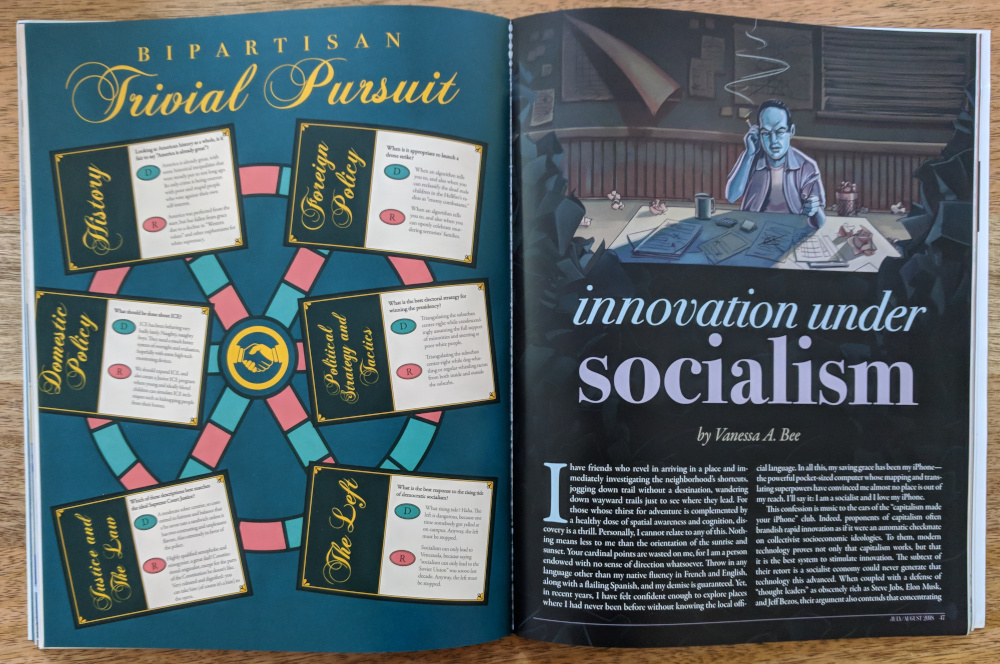Latest reviews
Spool created by Slant 3D to optimize the masterspool idea of a 2 piece reusable spool that accepts spoolless filament refills. The Slant Spool’s main change is switching from a threaded locking mechanism to a 1/4 turn mechanism and it works exactly as advertised. The mechanism change also allows both sides to be identical which simplifies printing and upkeep. The solid portion on the outside of the reel is perfect for the filament id sticker that comes with the refills. Lastly, there’s filament sized holes in the outside of the reel to hold the loose end when you’re not using the filament.
Website for 3D printing files made by members of the RepRap project. Website is clean and usable. The selection is much smaller than thingiverse which limits its usefullness.
In November 2015, Nathan Robinson and Oren Nimni launched a Kickstarter to fund the creation of Current Affairs, a print magazine of “political analysis, satire, and entertainment” promising to “make life joyful again”. The campaign exceeded its goal of $10,000. Three years later, Current Affairs has become of the most reliably interesting and, indeed, enjoyable political publications on the left.
Print editions are issued every two months; each is carefully designed and, in addition to articles on diverse topics, every issue contains the creative works of many contributing artists. While many illustrations simply support a given article, in other cases it’s the illustrations that tell the story—see, for example, the “City of Dreams” illustration and accompanying article.

Recent Current Affairs covers. (Credit: Current Affairs. Fair use.)
Chances are that you’ve come across Current Affairs articles before through some of Nathan Robinson’s in-depth “takedown” articles about prominent American and Canadian political writers — especially those spreading reactionary ideas, e.g., Ben Shapiro, Charles Murray, Sam Harris, Jordan Peterson, Mike Cernovich, and Dinesh D’Souza.
Instead of simply dismissing them outright, Robinson takes these figures to account on the basis of their own words, dissecting the ugly mess of hateful nonsense beneath whatever persona they’ve created for themselves.
Current Affairs is a decidedly leftist publication; it routinely condemns capitalist excess, corporate misconduct, “bipartisan” alliances with murderous regimes, the convenient political amnesia concerning America’s history of horrific military interventions, the dark legacy of racism at the root of deep social and economic inequalities.
While it writes of socialism as a political and economic alternative, the magazine has been equally critical of authoritarian socialism. Robinson’s own essay, “How To Be A Socialist Without Being An Apologist For The Atrocities Of Communist Regimes“, puts it quite plainly:
The dominant “communist” tendencies of the 20th century aimed to liberate people, but they offered no actual ethical limits on what you could do in the name of “liberation.” That doesn’t mean liberation is bad, it means ethics are indispensable and that the Marxist disdain for “moralizing” is scary and ominous.
Current Affairs instead leans towards libertarian socialism, an ideology seeking to balance a high commitment to individual freedom with a concern for the welfare of societies. It speaks of “humanistic” values and holds all ideologies to account for living up to those values.
The magazine publishes essays about diverse topics from the changing politics of Star Trek to the Mardi Gras holiday in New Orleans. You’re in for a visual treat the moment you open the table of contents, each of which is an artistic exploration of the topics covered in the current edition.

Current Affairs table of contents examples. (Credit: Current Affairs. Fair use.)
Alongside its playfulness and occasional silliness, the magazine features articles such as a gut-wrenching and unflinching look back at the Vietnam War (“What We Did”) or an insightful report on disillusioned African-American Rust Belt voters (“The Color of Economic Anxiety”).
Recently, the magazine also launched a podcast; as of this writing, it is already generating more than $6,000/month in Patreon support (supporters get access to bonus episodes). The podcast features conversations between the magazine’s contributors on a wide variety of topics, featuring segments like “Lefty Shark-Tank” (tongue-in-cheek criticism of left-wing policy ideas), interviews, answers to listeners, parody ads, and more.
Legally, Current Affairs is not a nonprofit; Nathan Robinson told me by email that the team “debated it and then decided against it as it creates all kinds of logistical headaches”.
However, he emphasized that Current Affairs will never operate as a for-profit company. Over the course of each magazine’s two-month run, all articles are published online without any kind of paywall, and the website and magazine are entirely free of third party ads. Regrettably, articles are under conventional copyright, as opposed to a permissive Creative Commons license.

Article example from the latest issue. (Credit: Current Affairs. Fair use.)
The Verdict
After reading their online edition for a while, I subscribed to Current Affairs earlier this year, and have not regretted it yet. At $60 for 6 issues, you get good value for your money; the magazine is a pleasure to look at, and I generally read it all the way through before the next one arrives.
A few typos usually slip through, and some articles would benefit from more rigor (data, citations) or additional editing. But these are the kinds of problems you would expect from a small, independent magazine.
In many ways, I prefer the Current Affairs model to the heavily grant-funded nonprofit publications I’ve reviewed (e.g., The Marshall Project, ProPublica). It will likely never be able to muster the resources to engage in a similar scale of reporting projects, but its writing is fearless and independent, funded entirely by readers. While its humor can be snarky, underneath it there’s an earnestness that’s disarming and likable. I highly recommend checking it out.
Would you enjoy reading it? Fortunately, that’s easy to find out by browsing the archives of the website. Regardless of its legal status, I’ve also added it to the Twitter feed of quality nonprofit media, which is a convenient way to sample the content of many nonprofit outlets if you happen to use Twitter.
A large repository of mostly openly licensed files for 3D printing. Instructions for printing the objects or why the objects exist can often be spotty. Be aware that this website is owned by Makerbot who is owned by Stratasys. Uploading or remixing a thing requires a Makerbot account.
Intro
I bought a spool in August since it’s $25 per KG and goes down with the volume you buy to $21 for 4 at a time. Matterhackers also has free shipping to anywhere in the US making this a good deal for PETG. The spool arrived in a vacuum sealed bag with desiccant inside. The first spool printed great with default Prusa PETG settings. Bed ahesion on a PEI printbed is very good if bed is clean. I ordered 2 more 1kg spools in September and have been having constant issues with material accumlating on the nozzle and then detaching leaving blobs and voids on parts. It’s unclear if the issue is with my printer or the material at this point. It’s unlikely I’ll be able to fully troubleshoot the problem in the near future since Matterhackers is out of stock.
Quality
Diameter measured an averaged of 1.73mm diameter taking multiple measurements with calipers on two different spools. This puts it well within the advertised spec of 1.75 ±0.07mm. No visible impurities were seen. Filament fed nicely off spool.
Print Settings
Prusa Generic PETG Settings 230C Extruder/85C Bed 1st layer, 240C/90C Bed after 1st layer
Matterhackers recommended print settings 230-255C Extruder/55-77C Bed
Availability
Matterhackers seems to have issues keeping their build series PETG in stock. This color has been out of stock for a couple of weeks and is estimated to be out of stock for another month.
Verdict
The pricing is good when buying several at a time, product arrives in a timely manner and product quality may be good (assuming the problem is with my printer). The availibilty issues combined with questions on quality leaves me looking for another source for PETG.
In 1971, Daniel Ellsberg leaked the Pentagon Papers to 19 newspapers. Comprising 7,000 pages, they are an internal history of the Vietnam War compiled by the US government. By doing so, Ellsberg made himself a target of the Nixon administration. The first operation of Nixon’s infamous “White House Plumbers” was the burglary of the offices of Ellsberg’s psychiatrist in order to find materials that could be used to discredit him. Later, members of the group would break into the Watergate hotel, bringing down Nixon’s presidency.
Secrets, first published in 2002, is Ellsberg’s memoir. It focuses on his work for the RAND Corporation and the Pentagon, including the time Ellsberg spent in South Vietnam, and the influences on his thinking that ultimately moved him to become a whistleblower.
A Harvard-educated intellectual, Ellsberg was quickly drawn into the upper echelon of US policymaking. In the early part of his memoir, he describes how, at the Pentagon, secrecy was used not just to conceal information from the public, but also to wage turf wars between departments, with new classifications being invented just to prevent rivals from seeing a certain memo or document.
He is not shy to admit the seductive and addictive nature of access to secrets, and how it breeds contempt from political insiders for the outside world. The public, after all, never knows the true reasons why a political decision was made, so how could the judgment of any member of the public be trusted? Lying to the public in official statements is so common that when lies are used to justify war — as was the case after the Gulf of Tonkin incident — it hardly seems notable to those on the inside.
From skeptic to cynic, from cynic to activist
Yet, Ellsberg was not a critic of this system at the time; he was a willing participant. When he was offered his role at the Pentagon with a specific focus on Vietnam policy, he was at first reluctant not because he questioned US motives in the war — as a Cold Warrior, he shared a desire to limit the spread of communist influence — but because he was skeptical that the war was winnable.
During his two years in South Vietnam, Ellsberg’s skepticism turned into cynicism, as he observed how, with all the unspeakable brutality of the war, there was no strategy or tactic that promised real gains against North Vietnam, short of the total destruction of the country. Moreover, forces on the ground even fabricated entire operations to pretend that “pacification” was around the corner at any moment.
Upon his return to the US, Ellsberg struggled to understand how successive presidencies could push forward a war that was going nowhere and costing hundreds of thousands of lives. Had these presidents simply been victims of their own propaganda? To find out, he participated in the creation of the report known as the Pentagon Papers. And it was his inside knowledge of the report, combined with his exposure to the peace movement, that ultimately caused him to become a whistleblower.
The Pentagon Papers showed that, far from cluelessly bumbling into war, the United States had recklessly escalated a war of aggression against a country that, to begin with, had sought independence from a colonial power, much as America had once done. But here, America had chosen the side of the colonizers.
Presidents Eisenhower, Kennedy and Johnson had willingly signed off on escalation after escalation, even as advisers were telling them that far greater efforts were needed to “win” the war. And it was the Nixon administration that would take the war to levels that can only be described as state terrorism, as Nixon himself promised privately: “We are not going to let this country be defeated by this little shit-ass country.” And he made it clear to Henry Kissinger: “You’re so goddamned concerned about the civilians—and I don’t give a damn. I don’t care.”
While Ellsberg would only learn about these statements when the Nixon White House tapes became public, he did know from insiders that Nixon was lying about pursuing peace in Vietnam, and that he was instead prepared to again escalate the war’s brutality in hopes of forcing North Vietnam to “negotiate” with the United States.
This threat of escalation motivated Ellsberg to try various venues to get the Pentagon Papers out, ultimately releasing them to many newspapers as a dramatic man-hunt against him got underway. The Pentagon Papers didn’t cover the Nixon period, and they mostly reflected poorly on previous Democratic administrations. Nevertheless, Ellsberg felt that making visible how administration after administration had made the same mistakes in Vietnam — and lied about it to the public — would at least help hold Nixon to account.
Nixon, for his part, privately welcomed the leak. It was only when he feared that Ellsberg had more material pertinent to his administration that he fully escalated an effort to silence Ellsberg. Aside from the break-in at his psychiatrist’s office, the Plumbers planned a physical attack against Ellsberg at a rally. In his own autobiography, Gordon Liddy confessed that the Plumbers even considered lacing Ellsberg’s soup with LSD before a public speech, to make him appear like a nutjob.
This criminal campaign failed, and as it was exposed, so did the indictment against Daniel Ellsberg. To this day, Ellsberg remains an outspoken activist against war and secrecy, and in defense of whistleblowers like himself.
The verdict
Secrets is an essential account of how secrecy can turn a republic into an empire, at least where foreign policy and “national security” are concerned. As a book about the Vietnam War, it cannot begin to scratch the surface of the horrors inflicted upon the Vietnamese. But to understand how we can prevent history from repeating itself — how we can undermine the secrecy machine by supporting whistleblowers, and how we must demand transparency whenever our government kills on our behalf — Secrets is as timely and necessary as ever.
Disclosure: I work for Freedom of the Press Foundation, where Ellsberg is a Board member.
As of this writing, James C. Scott is 81 years old. Best known for Seeing Like a State: How Certain Schemes to Improve the Human Condition Have Failed (reviews), he is an accomplished scholar of non-state societies. Near the end of his career, Scott is not pulling any punches. Against the Grain seeks to dismantle the standard civilizational narrative — that early state-based agricultural societies were part of a linear progression towards civilization as we understand it today.
Scott demonstrates that the hunter-gatherer lifestyle that preceded sedentary agriculture was egalitarian, relatively peaceful, and allowed for significant leisure time, and that early human cultures combined a variety of approaches to survive. Beyond hunting and gathering, these included shifting agriculture, pastoralism (raising livestock and moving the herd in search of new pastures), and even sedentary agriculture, well before the emergence of states.
Our ancestors were opportunistic and looked for the quickest way to make a living. Agriculture wasn’t necessarily a response to population pressure — depending on the environment, it just offered a more reliable return than hunting and gathering.
In Scott’s narrative, the creation of what he calls “late-Neolithic multi-species resettlement camps” — settlements where humans, livestock, other domesticated animals like dogs, and domesticated plants lived together for extended periods of time — caused never before seen levels of drudgery and misery. The high population concentration led to disease and crop failures, and agricultural cultivation created tedium and reduced cultural complexity.
But it also created opportunities for those who accumulated power to attempt to preserve it. The settlements could be strengthened by abducting and enslaving nomads or members of other communities. By standardizing on cereal grains — “visible, divisible, assessable, storable, transportable, and ‘rationable’” — early states were able to sustain their bureaucracies (and increase elite wealth) through taxation.
A polemic against civilization
War and slavery were not inventions of the state, Scott acknowledges, but it is only through the concentrated power of early states that they could they be brought to a previously unseen scale. When state societies collapsed, many of the enslaved or coerced members (if they survived—a big “if” Scott glosses over a bit too readily) were better off. And state collapse occurred frequently, due to disease, war, starvation, rebellion, and other causes.
Meanwhile, the “barbarians” who did not join state-based societies (and who could not easily be captured because of where they lived) became more sophisticated, extracting tribute from the state — but also selling each other out to serve as mercenaries for hire.
Where Scott’s writing turns into polemic is when he dismisses the idea of “dark ages” (such as the Greek Dark Age or, though he barely writes about it, the period following the collapse of the Roman Empire). The fact that we don’t find monumental buildings, wall paintings, or a strong written tradition, he reminds us, doesn’t mean nothing of interest happened — after all (a point Scott repeats), Homer’s great epic was composed during a “dark age” and transmitted orally.
Scott persuasively marshals the evidence that concentration caused many new hardships, and led to societies which were frequently (if not always) deeply unjust. But he does not attempt to examine the arguments against dispersal, or for large numbers of humans living with each other in close proximity, sharing ideas and beliefs at a pace previously unimagined.
He dismisses “elite displays” such as monuments and temples, but does not write about roads, aqueducts, libraries, poverty relief such as the Cura Annonae, or any legitimate effort to better the life of a community’s members, if such life was organized partially through a state.
Indeed, the word “science” does not appear in the book’s index. Human progression that is the result of better understanding our world and applying that knowledge is too readily dismissed in an effort to keep the book true to its title.
Here, Scott’s book — so critical of ideological views of “civilization” — is itself ideologically committed to rejecting an evidence-based view. “But what of the slaves?” one can imagine Scott saying. “But what of the elites, enriching themselves?” Yes, but what of Euclid, Democritus, Ovid? What of the Library of Alexandria, or the Antikythera mechanism, or the art of Pompeii? What of the religious extremism that followed Rome’s collapse, and probably followed earlier collapses as well?
The verdict
Scott uses language not to obfuscate, but occasionally in ways I would describe as performative. Against the Grain makes frequent use of technical terms from agriculture and anthropology; the writing is dry (though suffused with a dark academic humor) and sometimes repetitive. What keeps the book interesting is its challenge to orthodoxies and its willingness to put things plainly when required, e.g., when writing about slavery.
Against the Grain does re-cast our understanding of history. Scott is correct to critique those who want to see linear progression in human history; a rise from savagery. Deep history that looks at the distant past of our species is crucial to get a clear picture of how we became who we are. Our hunter-gatherer ancestors were far from stupid, and their minds were far from simplistic compared to our own, nor were their lives especially brutal or difficult.
History cannot be understood without examining the accumulation of power and resources, all too often including slaves and other coerced labor. If we want to build morally just societies, we must understand how this accumulation of power is at odds with moral progress, even as it has often enabled scientific or technological progress.
But here ends the usefulness of Scott’s book. The fact that his work celebrates the dispersed life beyond the reach of the state is perhaps precisely why his colleagues can celebrate him as an anarchist academic. His writing poses no threat to real systems of power, because it offers no alternative. It is an important read, but only as a starting point for developing a more nuanced understanding of the human story, correcting misconceptions in the common narrative still taught in schools. In the final analysis, Scott is a rebel without a cause.
Slic3r is an open source slicing program with the features you’d expect. The Prusa edition adds in some integration with Prusa printers to make program setup a bit easier.
UI
UI is pretty and works well for common tasks. There are some menus and advanced features that are inscrutable until you go through the documentation. You have to manually keep track of which tab you are in. Parts only show up in 3D and 2D tabs until they have been sliced, then you can see more in preview and layers tabs. Settings are nicely laid out across 3 tabs at the top.
Slicing
Everything works quickly and as expected.
Verdict
Good piece of software made better with printer integration. Easy things are easy and hard things are possible(once you read the docs).
Julia Rothman is an illustrator from New York; in Nature Anatomy: The Curious Parts & Pieces of the Natural World she expresses her love of nature through 223 pages filled with colorful sketches, brief explanations and descriptions.
The art is simple but elegant, conveying the most recognizable characteristics of a leaf, a mushroom or a butterfly in just a few strokes. The organization varies from page to page:
-
annotated illustrations (“anatomy of a flower”) with brief explanations;
-
illustrations without any text or explanation other than a species name;
-
illustrations with brief facts about a species (“Woodchuck: Woodchucks can climb trees if they need to escape”)
-
recipes and other offbeat material, e.g., instructions for printing plant patterns.

This kind of presentation is fairly typical for the book: elegant illustrations accompanied by one or two facts. (Credit: Julia Rothman. Fair use.)
Of course, the book can only sample the natural world (and it does so with a North American bias), but it does attempt to provide some broader explanations as well, e.g., about moon phases or the layers of Earth’s atmosphere.
Some of the text is in cursive, giving the book the feel of an intimate journal. That’s clearly the idea: making the complexity of nature less intimidating by focusing on its beauty and by conveying descriptions and explanations in a casual manner.
At the same time, this approach can no more than whet the appetite for more detailed explanations why nature is the way it is (for which speaking about evolution, which this book hardly does, is essential).
Is this approach suitable for getting young people excited about the natural world? I’m no longer a young reader, but if I was, I bet I would have been in equal parts frustrated and pulled in by this book; pulled in by its art, and frustrated by its failure to go beyond enumerating names and facts. I would give the book 5 stars for art and 3 stars for the text—a good purchase for extending one’s appreciation of the patterns of nature, if not necessarily for understanding them.
With tough, knobbly bark and branches spaced closely but not too closely, this tree invites you to gently ascend to it’s sturdy mid-trunk branches to take in the view and be embraced by lightly-scented twigs.
